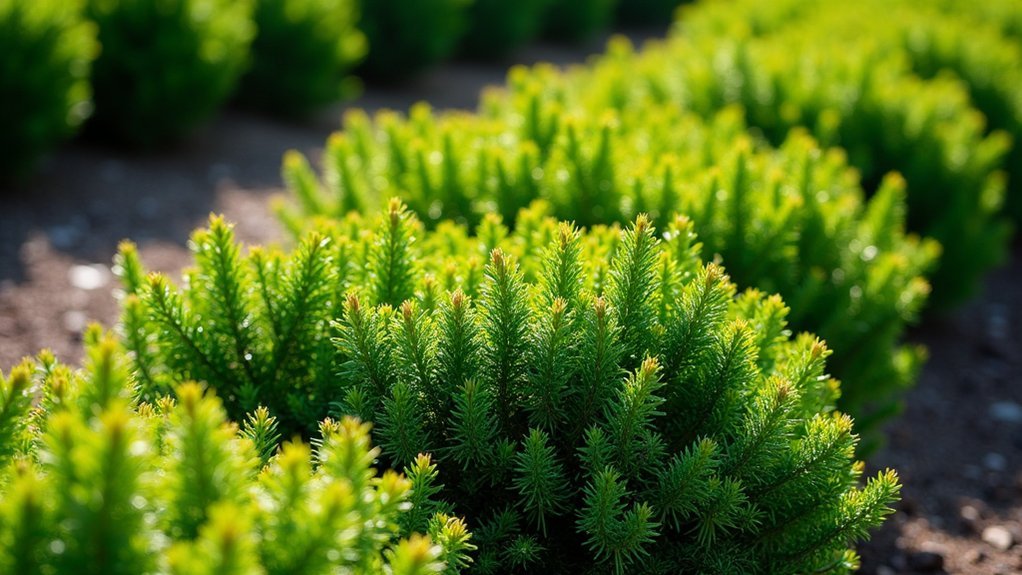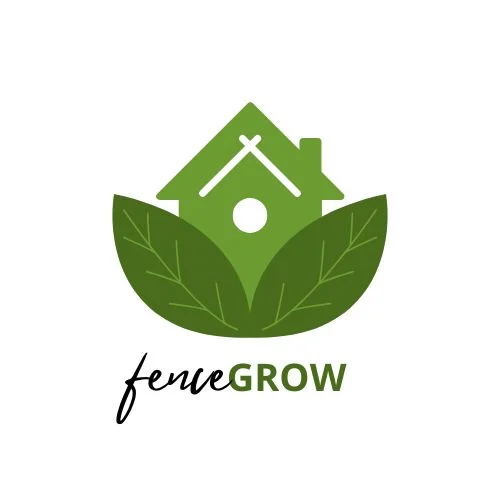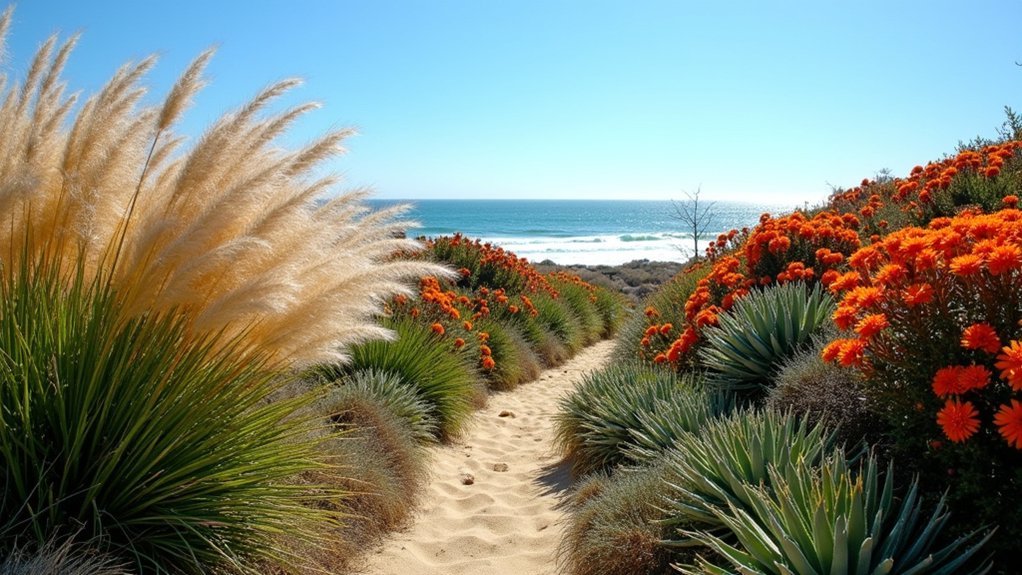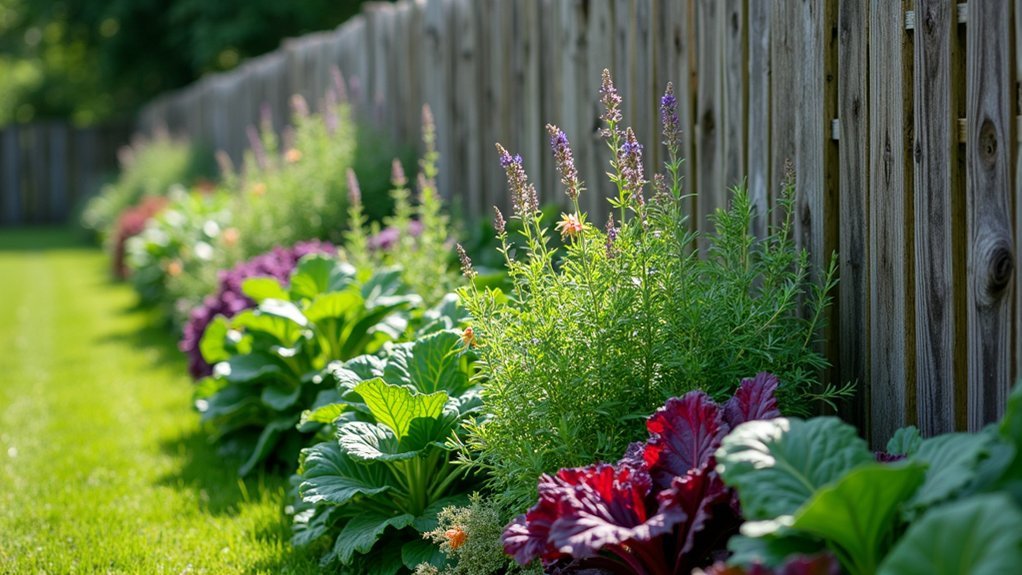Native evergreen shrubs create natural, low-maintenance boundary hedges while supporting local wildlife. Consider American Holly for dense privacy with red winter berries, Mountain Laurel for shade-loving boundaries with spring flowers, or drought-tolerant Eastern Red Cedar for taller screens. Other excellent choices include Wax Myrtle, California Lilac, Inkberry Holly, and Yaupon Holly. Select varieties suited to your USDA zone for thriving boundaries that need minimal care and provide year-round interest.
Benefits of Using Native Evergreens as Boundary Hedges

While many homeowners default to non-native options, native evergreen shrubs offer compelling advantages for boundary hedges that extend far beyond basic privacy.
When you choose local species, you’re investing in plants specifically adapted to your region’s climate conditions, resulting in more drought tolerant boundaries that require less watering and maintenance.
Your privacy hedge will serve multiple purposes when composed of native evergreens.
These versatile plants create year-round screening while simultaneously supporting local wildlife and pollinators.
You’ll reduce your environmental footprint too, as these plants typically need fewer chemical inputs than exotic alternatives.
With various heights and growth habits available, you can select native species that perfectly match your specific boundary needs while enhancing your landscape’s natural aesthetic appeal.
Selecting the Right Native Evergreen for Your Climate Zone
Because climate conditions greatly impact plant survival, identifying your USDA hardiness zone is the essential first step when selecting native evergreen shrubs for boundary hedges.
Most suitable native shrubs thrive in Zones 3 to 9, offering options for nearly every region.
For colder areas (Zones 2-9), consider Eastern Red Cedar, which grows 40-50 feet tall and creates an impressive privacy hedge.
In warmer regions (Zones 8-10), Southern Wax Myrtle delivers drought tolerance with year-round greenery.
If space is limited, Yaupon Holly ‘Scarlet’s Peak’ reaches 20 feet while maintaining a narrow profile in Zones 7-10.
Walter’s Viburnum offers a medium-sized option at 12 feet, thriving in Zones 8-10 with the bonus of seasonal flowers and dense coverage.
American Holly (Ilex Opaca): a Stately Boundary Solution

American Holly creates a magnificent year-round privacy screen with its dense, spiny foliage that effectively blocks unwanted views from neighbors.
You’ll appreciate how this stately native transforms your property line into a wildlife sanctuary, as its bright red berries attract and nourish birds throughout winter.
The evergreen’s 15-30 foot mature height offers substantial boundary definition while providing valuable habitat for local fauna.
Year-Round Privacy Barrier
When privacy becomes a priority for your landscape, the majestic American Holly stands ready to transform property boundaries into elegant living walls. This impressive evergreen shrub creates a dense, impenetrable screen that maintains its lush appearance throughout all seasons, offering the perfect privacy hedge for your home.
Growing up to 30 feet tall, American Holly’s thick foliage effectively blocks unwanted views while its distinctive spiny leaves and vibrant red berries provide year-round interest.
You’ll appreciate how this native plant not only shields your outdoor spaces but also dampens noise from busy streets or neighboring properties.
The holly’s adaptability to various soil conditions across zones 5-9 means you won’t need to struggle with complex maintenance routines – it naturally retains its attractive form with minimal pruning required.
Wildlife-Supporting Sanctuary
Beyond its impressive privacy benefits, the stately American Holly transforms your property line into a thriving wildlife sanctuary throughout the year.
When you plant this native evergreen, you’re creating more than just a privacy screen—you’re establishing an essential ecosystem component.
American Holly’s vibrant red berries serve as important winter sustenance for birds when other food sources become scarce. Its dense, spiny foliage provides excellent nesting sites and protection from predators and harsh weather conditions.
You’ll appreciate how this adaptable shrub thrives in zones 5-9 across various soil types, even performing well in shaded areas where other plants struggle.
Standing 15-30 feet tall at maturity, this wildlife-supporting hedge offers year-round interest while fulfilling significant ecological functions in your landscape’s boundary areas.
Mountain Laurel (Kalmia Latifolia): Dense Privacy With Stunning Blooms
Mountain Laurel’s dense evergreen foliage creates effective property boundaries that maintain your privacy throughout all seasons.
You’ll enjoy a spectacular display of pink or white flower clusters in late spring, transforming your hedge into a focal point that attracts beneficial pollinators.
This versatile native thrives in shaded areas where many hedge options struggle, making it an excellent choice for woodland edges or north-facing property lines.
Year-Round Screening Capabilities
Though many deciduous shrubs leave your yard exposed during winter months, Kalmia latifolia stands as a superior boundary solution with its persistent foliage. Unlike seasonal plants, Mountain Laurel’s evergreen foliage maintains privacy throughout all seasons, creating a consistent visual barrier. Its glossy dark green leaves remain vibrant even during the coldest months, ensuring your landscape maintains its polished appearance year-round.
| Season | Screening Density | Visual Appeal |
|---|---|---|
| Spring | Excellent | Spectacular (flowering) |
| Summer | Complete | Rich and Lush |
| Fall | Full | Elegant and Refined |
| Winter | Undiminished | Steadfast and Reliable |
| Year-Round | Consistent | Sophisticated |
You’ll appreciate how this native evergreen provides continuous screening while contributing ecological value, making it an investment that delivers privacy and beauty in every season.
Spring Flower Spectacle
While providing excellent privacy throughout the year, Kalmia latifolia transforms into a breathtaking spectacle each spring when clusters of intricate pink to white blossoms emerge against the dark green foliage.
This evergreen shrub creates a stunning visual display between late May and early June, drawing pollinators to your garden boundary.
You’ll appreciate how these fragrant white to pink blooms enhance your landscape’s aesthetic appeal while the plant continues functioning as a privacy screen.
Growing 5-15 feet tall, Mountain Laurel combines utility with seasonal beauty in USDA zones 4-9.
What makes this spring flower spectacle particularly valuable is that it occurs on a plant that’s already working hard in your garden—offering deer resistance, shade tolerance, and year-round screening with its glossy evergreen leaves.
Shade-Tolerant Native Choice
Unlike many flowering shrubs that demand full sun, Kalmia latifolia thrives beautifully in shadier locations where other privacy hedges might struggle.
This versatile native plant grows 10-15 feet tall and 5-10 feet wide, creating dense privacy screens in challenging lighting conditions.
You’ll appreciate Mountain Laurel’s shade-tolerant nature when establishing boundary plantings, especially in these situations:
- North-facing property lines
- Areas beneath mature tree canopies
- Spaces receiving less than 4 hours of direct sunlight
With its year-round evergreen foliage and spectacular spring blooms, Mountain Laurel delivers both function and beauty.
It’s perfectly adapted to acidic, well-drained soils across USDA zones 4-9, making it an excellent choice for privacy hedges throughout the eastern United States.
Eastern Red Cedar (Juniperus Virginiana): Drought-Tolerant Screening
When seeking a resilient native evergreen for boundary hedges, the Eastern Red Cedar (Juniperus virginiana) stands out as an exceptional choice.
This fast-growing shrub reaches impressive heights of 40-50 feet with a spread of 8-20 feet, creating an effective privacy screen and windbreak for your property.
As a drought-tolerant hedge plant, Eastern Red Cedar thrives in challenging conditions where other species might struggle.
You’ll appreciate its adaptability to various soil types and its ability to flourish across USDA zones 2-9.
The dense, year-round foliage offers complete coverage for boundary definition while enhancing your landscape’s visual appeal.
Beyond its screening capabilities, this versatile native attracts birds with its blue berries, supporting local wildlife and adding ecological value to your property line investment.
Wax Myrtle (Myrica Cerifera): Aromatic Natural Fencing

For homeowners seeking a multi-talented native evergreen, Wax Myrtle (Myrica cerifera) offers an aromatic natural fencing solution that excels in versatility. This impressive shrub grows 10-15 feet tall, creating an effective boundary hedge that provides both privacy and wildlife habitat with its bluish berries.
You’ll appreciate Wax Myrtle’s adaptability in your landscape design:
- Thrives in full sun to part shade conditions, accommodating various garden layouts.
- Tolerates different soil types while requiring minimal maintenance once established.
- Provides year-round screening with fragrant foliage that enhances your outdoor experience.
Wax Myrtle’s drought tolerance makes it particularly valuable for sustainable landscaping in warmer regions, reducing your water usage while still maintaining an attractive, functional boundary that supports local biodiversity.
California Lilac (Ceanothus): Western Native With Vibrant Color
Splashes of vibrant blue transform your boundary hedge with California Lilac (Ceanothus), a stunning western native that combines beauty with practicality. Growing up to 10 feet tall and wide, this evergreen shrub creates impressive boundary hedges while requiring minimal maintenance once established.
| Feature | Benefit | Best For |
|---|---|---|
| Dark green leaves | Year-round screening | Privacy hedges |
| Deep blue flowers | Attracts pollinators | Biodiversity |
| Drought tolerant | Water conservation | Western gardens |
You’ll appreciate how this versatile shrub adapts to various soil conditions, though it performs best in well-draining, neutral pH environments. Hardy in USDA zones 8-11, California Lilac offers the perfect blend of functionality and beauty. Its dense foliage provides excellent screening while supporting local wildlife, making it an eco-friendly choice for your landscape.
Inkberry Holly (Ilex Glabra): Low-Maintenance Boundary Planting

You’ll appreciate Inkberry Holly’s dense, glossy foliage that creates an effective year-round privacy screen without demanding extensive maintenance.
This drought-tolerant native adapts well to various soil conditions while maintaining its attractive form in growing zones 5-9.
The small black berries that appear after inconspicuous flowers provide valuable winter food sources for local birds, enhancing your property’s ecological value.
Year-round Privacy Screen
When selecting boundary plants that offer both beauty and privacy, Inkberry Holly (Ilex glabra) stands out as an exceptional choice. This versatile native evergreen provides a year-round privacy screen while maintaining an attractive appearance in your landscape.
Though not quite a small tree, its 5-8 foot mature height creates substantial visual barriers without overwhelming your property.
You’ll appreciate these key benefits:
- Dense evergreen foliage that maintains its glossy, dark green appearance throughout all seasons
- Adaptability to medium moisture conditions once established, requiring minimal watering
- Wildlife support through winter berries that attract birds while creating additional screening
Inkberry Holly thrives in various soil types across USDA zones 5-9, making it an ideal candidate for property boundaries where you want consistent screening without extensive maintenance commitments.
Drought-Tolerant Native Option
Gardeners facing water restrictions or drought-prone regions will find Inkberry Holly (Ilex glabra) an exceptional boundary solution. This drought-tolerant native grows 5-8 feet tall, making it perfect for properties with limited space while still providing effective screening.
You’ll appreciate how these evergreen shrubs maintain glossy, dark green foliage year-round with minimal maintenance. They thrive in acidic, well-draining soil across USDA zones 5-9, adapting easily to various landscape conditions.
Beyond their practical benefits, Inkberry Hollies produce black berries that attract birds during winter months, enhancing your garden’s ecological value.
Their low-maintenance nature means you’ll spend less time pruning and more time enjoying your landscape. For homeowners seeking hassle-free boundary plantings that combine privacy with environmental benefits, Inkberry Holly delivers impressive results.
Wildlife Habitat Benefits
While creating an attractive boundary, Inkberry Holly transforms your garden into a thriving wildlife sanctuary. This versatile evergreen shrub provides year-round shelter for local fauna while maintaining privacy for your property.
Standing 5-8 feet tall, Inkberry Holly requires minimal maintenance yet delivers maximum ecological impact.
Your garden becomes a wildlife habitat when you plant this native species, offering:
- Winter food source through small black berries that attract diverse bird species
- Dense evergreen foliage providing protective cover for birds and small mammals throughout the year
- Sustainable ecosystem support that enhances local biodiversity without demanding extensive care
You’ll appreciate how Inkberry Holly thrives in various soil conditions, particularly acidic and well-draining environments, making it an adaptable choice for creating boundaries that benefit both you and your local ecosystem.
Planting and Maintenance Tips for Evergreen Boundary Hedges

Successfully establishing a thriving evergreen boundary hedge requires careful planning and consistent maintenance throughout the seasons.
When planting evergreen shrubs, space them 2-3 feet apart to allow for their mature width while achieving quicker coverage. This spacing strikes the perfect balance between immediate privacy and long-term health.
Water your newly planted hedge consistently until established, paying special attention during drought periods in the first few growing seasons.
Consistent watering is the lifeline of new hedges—your vigilance during dry spells determines their ultimate success.
Come early spring, apply a balanced fertilizer to promote vigorous growth and lush foliage.
Your hedges should be regularly pruned back to maintain their desired shape and encourage density.
This practice not only keeps them looking tidy but also removes dead or damaged branches, ensuring your boundary remains healthy and effective year-round.
Pairing Compatible Native Plants for Biodiversity in Your Living Fence
Beyond basic maintenance, a truly exceptional boundary hedge offers more than just privacy—it creates a vibrant ecosystem right in your yard.
By combining diverse native evergreen shrubs like Yaupon Holly and Eastern Red Cedar, you’ll provide year-round habitat and food sources for local birds.
Creating layers with different heights—tall Southern Wax Myrtle above shorter Inkberry Holly—supports more wildlife varieties and strengthens your living fence’s ecological value.
Mix flowering natives like Witch Hazel with evergreens to attract pollinators while maintaining year-round screening.
For maximum biodiversity benefits:
- Select compatible native plants adapted to your local soil and climate
- Incorporate varying heights, textures, and seasonal interest
- Include at least three different native species to create resilient plant communities
Your boundary hedge will become a thriving corridor for nature’s interactions.
Frequently Asked Questions
What Are the Best Evergreen Shrubs for Privacy Hedge?
For privacy hedges, you’ll find Boxwood, Holly, Cherry Laurel, Yaupon Holly ‘Scarlet’s Peak’, and Eastern Red Cedar are excellent evergreen choices. They offer dense foliage, year-round coverage, and varying heights for effective screening.
What Is the Quickest Growing Native Hedge?
Eastern Red Cedar is your quickest growing native hedge option. You’ll achieve privacy fast as it reaches 40-50 feet with dense foliage. Southern Wax Myrtle also grows rapidly to 15 feet.
What Is a Native Alternative to Arborvitae?
You can replace arborvitae with Eastern Red Cedar, which grows 40-50 feet tall with dense foliage. Yaupon Holly ‘Scarlet’s Peak’ is another excellent native alternative that reaches 20 feet with a narrower profile.
What Is the Best Native Hedge for Wildlife?
You’ll find American Holly and Eastern Red Cedar support diverse wildlife. They’ll provide year-round shelter and food. Don’t overlook Yaupon Holly and Wax Myrtle for attracting birds and pollinators to your landscape.
In Summary
You’ll create a lasting legacy by choosing native evergreen shrubs for your boundary hedge. They’re not just beautiful barriers—they’re wildlife havens that strengthen your local ecosystem. Whether you’ve selected mountain laurel for its blooms or inkberry for its simplicity, you’ve made a sustainable choice that’ll reward you with privacy, protection, and natural beauty for decades to come.





Leave a Reply